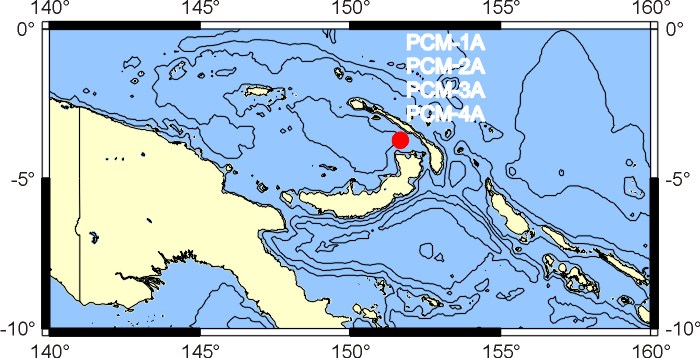
Leg 193Anatomy of a Felsic Volcanic-Hosted Hydrothermal System: Eastern Manus Back-Arc BasinThe objectives of Leg 193 are to study the magmatic-fluid interactions in a felsic volcanic-hosted hydrothermal system. This will be accomplished by: 1) looking at mineralogical, geochemical, and isotopic analyses of mineralized veins and alteration intervals below outflow zones; 2) comparing investigations below shallow and deep inflow zones, particularly using isotopes for tracing the deposition of seawater derived anhydrite and; 3) by performing quantitative modeling of the entire hydrological system using physical and chemical constraints derived from studies of core samples and wall structures of the boreholes.
Drilling Plan Four holes are to be drilled in the area of hydrothermal activity. High temperatures and hole conditions may be poor, so logging will be of considerable importance in obtaining data. The logging program for the Leg 193 is designed to obtain the physical, chemical, and structural data essential for characterizing the hydrological parameters, lithological boundaries, and structural features that constrain this hydrological system. In the case of poor core recovery, resistivity, gamma-ray, density and geochemical (GLT) log profiles will define the extent of mineralization in the boreholes much more accurately than the cores alone. Formation MicroScanner (FMS), resistivity and porosity data will allow definition of fracture patterns associated with potential permeable zones and hydrothermal fluid flow. In addition, array acoustic waveform data containing low-frequency Stoneley waves can be used for the detection of permeable fractures and the estimation of fracture hydraulic conductivity. The "hole cooling during drilling" strategy that ODP has adopted and used in potentially high-temperature (>165°C) holes in the past (i.e. TAG site, Juan de Fuca Ridge, 504B) will sufficiently depress borehole temperatures into a range such that most of the standard logging tools can be used. Using the side-entry sub (with some extra time) allows for hole cooling by pumping during logging operations. Standard logging tools can be run reliably to approximately 165°C. The LDEO and/or University of Miami high-T temperature tools are recommended for use at elevated borehole temperatures. In the event that hole conditions are poor, the LWD resistivity and gamma ray tool (CDR) will be available. Since key mineralization zones are located immediately below the seafloor, the CDR will allow these shallow (<90 mbsf) zones to be logged with minimal hole degradation. The CDR log is obtained without stopping to recover core, reducing the chances of borehole wall collapse. The CDR records gamma-ray and borehole-compensated deep and shallow resistivity measurements, permitting correlation between holes and assessment of lithology and fracturing. The temperature limit for the CDR is 150oC, but pumping while drilling with LWD should cool the hole continuously and significantly more than during wireline logging. If additional funding becomes available, a more robust approach can be achieved by deploying resistivity-at-the-bit (RAB) and/or azimuthal density neutron (ADN) tools. These LWD tools measure azimuthal density and reliable neutron porosity (ADN) in high-porosity environments and provide at-the-bit resistivity (RAB) and resistivity images, which are similar to an FMS log. The resistivity and density azimuthal data, as well as measurements made at the bit itself, can be particularly valuable for investigations of macrostructures within faults or fractures. The data should be obtained before any significant hole degradation or pore pressure changes occur. With this enhanced LWD approach, the ephemeral and physical properties in fractured environments can be observed and more accurately interpreted.
Staff Scientist: Jay Miller Operations Schedule | Back to FY 01-02 Abstracts
|
